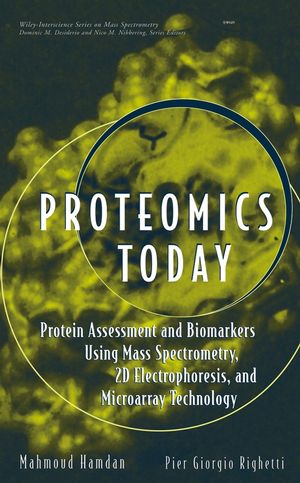Proteomics Today: Protein Assessment and Biomarkers Using Mass Spectrometry, 2D Electrophoresis,and Microarray TechnologyISBN: 978-0-471-64817-8
Hardcover
448 pages
February 2005
 This is a Print-on-Demand title. It will be printed specifically to fill your order. Please allow an additional 10-15 days delivery time. The book is not returnable.
|
||||||
ACKNOWLEDGMENT.
I: INTRODUCTION TO PART I.
1. INSTRUMENTATION AND DEVELOPMENTS.
1.1 Introduction.
1.2 Ionization Techniques for Macromolecules.
1.3 Examples on Analytical Solutions Based on FAB–MS.
1.4 Electrospray Ionization.
1.5 Matrix-Assisted Laser Desorption Ionization.
1.6 Ion Detection.
1.7 Types of Analyzers.
1.8 Hybrid Analyzers.
1.9 Tandem Mass Spectrometry.
1.10 Current MS Instrumentation in Proteome Analyses.
1.11 Current MS-Based Proteomics.
1.12 Recent Achievements and Future Challenges.
1.13 Concluding Remarks.
References.
2. PROTEOMICS IN CANCER RESEARCH.
2.1 Introduction.
2.2 Pancreatic Ductal Adenocarcinoma.
2.3 Proteomic Analysis of Human Breast Carcinoma.
2.4 Proteomic Profiling of Chemoresistant Cancer Cells.
2.5 Signal Pathway Profiling of Prostate Cancer.
2.6 Emerging Role of Functional and Activity-Based Proteomics in Disease Understanding.
2.7 Activity-Based Protein Profiling.
2.8 Probing Protein Functions Using Chromophore-Assisted Laser Inactivation.
2.9 Role of Protein–Tyrosine Kinases.
2.10 Concluding Remarks and Future Prospects.
References.
3. CURRENT STRATEGIES FOR PROTEIN QUANTIFICATION.
3.1 Introduction.
3.2 Global Internal Standard Technology.
3.3 Differential In-Gel Electrophoresis.
3.4 Quantification of Modified Proteins.
3.5 Comments and Considerations.
3.6 Other Approaches.
3.7 Emerging Role of Microfluidic Devices.
3.8 Concluding Remarks.
References.
II: PROTEOMICS TODAY: SEPARATION SCIENCE AT WORK.
4. CONVENTIONAL ISOELECTRIC FOCUSING IN GEL MATRICES AND CAPILLARIES AND IMMOBILIZED pH GRADIENTS.
4.1 Introduction.
4.2 Conventional Isoelectric Focusing in Amphoteric Buffers.
4.3 Immobilized pH Gradients.
4.4 Capillary Isoelectric Focusing.
4.5 Separation of Peptides and Proteins by CZE in Isoelectric Buffers.
4.6 Conclusions.
References.
5. SODIUM DODECYL SULFATE–POLYACRYLAMIDE GEL ELECTROPHORESIS.
5.1 Introduction.
5.2 SDS–Protein Complexes: a Refinement of the Model.
5.3 Theoretical Background of Mr Measurement by SDS–PAGE.
5.4 Methodology.
5.5 Gel Casting and Buffer Systems.
5.6 Blotting Procedures.
5.7 Conclusions.
References.
6. TWO-DIMENSIONAL MAPS.
6.1 Introduction.
6.2 Some Basic Methodology Pertaining to 2D PAGE.
6.3 Prefractionation Tools in Proteome Analysis.
6.4 Multidimensional Chromatography Coupled to MS.
6.5 Protein Chips and Microarrays.
6.6 Nondenaturing Protein Maps.
6.7 Spot Matching in 2D Gels via Commercial Software.
6.8 Conclusions.
References.
INDEX.



